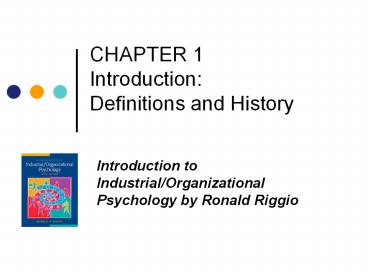CHAPTER 1 Introduction: Definitions and History - PowerPoint PPT Presentation
Title:
CHAPTER 1 Introduction: Definitions and History
Description:
CHAPTER 1 Introduction: Definitions and History Introduction to Industrial/Organizational Psychology by Ronald Riggio What is Industrial/ Organizational Psychology? – PowerPoint PPT presentation
Number of Views:301
Avg rating:3.0/5.0
Title: CHAPTER 1 Introduction: Definitions and History
1
CHAPTER 1 Introduction Definitions and History
- Introduction to Industrial/Organizational
Psychology by Ronald Riggio
2
What is Industrial/Organizational Psychology?
- Psychology is the study of behavior and mental
processes. - Industrial/organizational (I/O) psychology is the
specialty area within psychology that is
concerned with - The study of behavior in work settings.
- The application of psychology principles to
change work behavior.
3
The Science and Practice of Industrial/Organizatio
nal Psychology
- I/O psychology has two objectives
- To conduct research in an effort to increase our
knowledge and understanding of human work
behavior. - To apply that knowledge to improve work behavior,
the work environment, and the psychological
conditions of the worker.
4
(No Transcript)
5
The Roots and Early History of Industrial/Organiza
tional Psychology
- Around the turn of the 20th century, Frederick
Taylor, an engineer, believed that scientific
principles could be applied to the study of work
behavior. - Scientific management, a movement started by
Taylor, was a method of using scientific
principles to improve the efficiency and
productivity of jobs.
6
The Roots and Early History of Industrial/Organiza
tional Psychology
- Taylor developed time-and-motion studies ?
procedures in which work tasks are broken down
into simple component movements timed to develop
a more efficient method for performing the tasks.
7
The Roots and Early History of Industrial/Organiza
tional Psychology
- During World War I, Robert Yerkes worked with the
U.S. Army to develop intelligence tests for army
recruits. - The Army Alpha and Beta tests represented the
first mass testing efforts.
8
The Great Depression Years and World War II
- Because of the economic depression during the
1930s, fewer opportunities existed for industrial
psychologists. - However, a group of Harvard psychologists
conducted studies at the Western Electric
Company in Hawthorne, Illinois.
9
The Great Depression Years and World War II
- Elton Mayo and his colleagues examined the
effects of the physical environment on worker
productivity. - In one particular study, they examined the effect
of lighting on worker productivity. - Results of the study found that productivity
increased regardless of level of lighting.
10
The Great Depression Years and World War II
- The Hawthorne effect refers to changes in
behavior occurring as a function of participants
knowledge that they are being observed and their
expectations concerning their role as research
participants.
11
The Great Depression Years and World War II
- The human relations movement was a movement based
on the studies of Elton Mayo that emphasizes the
importance of social factors in influencing work
performance. - Worker morale
12
The Great Depression Years and World War II
- World War II contributed greatly to the growth of
I/O psychology. - State-of-the-art machinery lead to a need for
human factors psychologists. - The Army General Classification Test was
developed.
13
Industrial/Organizational Psychology Today and in
the Future
- Four Trends
- First trend The changing nature of work
- Organizational downsizing refers to the strategy
of reducing an organizations workforce to
improve organizational efficiency and/or
competitiveness. - Second trend Expanding focus on human resources
- Competition for highly-skilled workers
- Growing number of low-skilled workers in the
service industry
14
Industrial/Organizational Psychology Today and in
the Future
- Third trend Increasing diversity in the
workforce - Workforce is becoming more diverse
- Women make up two thirds of all entering workers
in the labor market. - Ethnic minority group members make up one third
of all entering workers.
15
Industrial/Organizational Psychology Today and in
the Future
- Fourth trend Increasing globalization of
business - More businesses are focusing on the global
economy. - Potential issues for worker training

